What Is 1-Wire Technology?
The basis of 1-Wire technology is a serial protocol using a single data line plus ground reference for communication. A 1-Wire master initiates and controls the communication with one or more 1-Wire slave devices on the 1-Wire bus (Figure 1). Each 1-Wire slave device has a unique, unalterable, factory-programmed, 64-bit ID (identification number), which serves as device address on the 1-Wire bus. The 8-bit family code, a subset of the 64-bit ID, identifies the device type and functionality. Typically, 1-Wire slave devices operate over the voltage range of 2.8V (min) to 5.25V (max). Most 1-Wire devices have no pin for power supply; they take their energy from the 1-Wire bus (parasitic supply).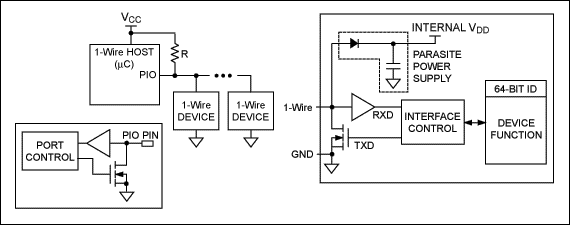
Figure 1. The 1-Wire master/slave configuration uses a single data line plus ground reference.
What Is Special About 1-Wire?
1-Wire is the only voltage-based digital system that works with two contacts, data and ground, for half-duplex bidirectional communication. In contrast to other serial communication systems such as I2C or SPI?, 1-Wire devices are designed for use in a contact environment. Either disconnecting from the 1-Wire bus or a loss of contact puts the 1-Wire slaves into a defined reset state. When the voltage returns, the slaves wake up and signal their presence. With only one contact to protect, the built-in ESD protection of 1-Wire devices is extremely high. With two contacts, 1-Wire devices are the most economical way to add electronic functionality to nonelectronic objects for identification, authentication, and delivery of calibration data or manufacturing information.How Are 1-Wire Devices Packaged?
1-Wire devices are offered in conventional transistor (TO-92) and IC packages (TSOC, SOIC, SOT23). Designed for contact applications and easy attachment, the 2-contact SFN1 package accommodates parasitically powered 1-Wire devices (Figure 2). The 16mm-diameter stainless steel iButton?2 package protects 1-Wire devices from harsh environments, making them suitable for indoor and outdoor use (Figure 3). Many devices are also available in flip chip (Figure 4) and UCSP?3 (Figure 5) versions.Figure 2. The 6.0mm x 6.0mm x 0.9mm SFN package has large contact areas.
Figure 3. The 16mm-diameter iButton package protects the 1-Wire chip inside from harsh environments.
Figure 4. The flip chip DS2502 package, 1.6mm x 0.91mm, has two rectangular contacts.
Figure 5. The UCSP package, 1.68mm x 1.68mm, for the DS2431 has spherical contacts located on a grid with a 0.5mm pitch.
What Device Functions Are Available, and What Are the Typical Applications?
At this time, there are approximately 40 1-Wire devices, including some close to the end of their lifetime. The part numbers listed here only include devices scheduled for normal production for the foreseeable future. Part numbers that begin with DS19 are always iButtons. The remaining part numbers in this section, i.e., those that begin with DS24, DS25, and DS28 are available in conventional plastic packages. If a product is also available as SFN or flip chip/UCSP, then this is mentioned in the Notes column. To find up-to-date package information for any device, go to the Maxim website and enter the part number in the part number search field.1-Wire devices can be grouped by their functions into several categories:
- Identification only
- Identification plus control
- Identification plus temperature
- Identification plus time
- Identification plus NV SRAM
- Identification plus (one time programmable) OTP EPROM
- Identification plus EEPROM
- Identification plus SHA-1 secure EEPROM
- Identification plus logging
Identification Only
Devices in this category are notable for their low cost. Accordingly, the level of protection that they can provide is limited. If the DS2401 or DS2411 is used for the protection of intellectual property (IP), one should consider a customized version of the device. See section Is There Any Device Customization? for more details.| Part Number | Notes | Typical Applications |
| DS2401 | The DS2401 is also available as flip chip. Since the DS2401 does not need a VCC supply, this part is also suitable for identification of printer cartridges and medical consumables. |
|
| DS2411 | VCC power, 1.5V or higher | |
| DS1990A DS1990R |
The DS1990R is guaranteed to generate a presence pulse on contact to reader. |
|
Identification plus Control
The applications for these parts are similar to the devices above. The PIOs, however, add control or feedback capability to the system.| Part Number | Notes | Typical Applications |
| DS2413 | Two 28V PIOs |
|
| DS2450 | Four 5V ADC inputs, which can also function as digital PIO. This device can be VCC powered. |
|
Identification plus Temperature
In large electronic equipment (racks) the proper cooling/air flow is critical for reliable operation. The DS28EA00 solves this problem in a unique way through its chain function,4 which allows detecting the physical sequence of the device on the 1-Wire bus. When wired for sequence detection, one of the two PIOs is available for control functions.| Part Number | Notes | Typical Applications |
| DS28EA00 | If not wired for sequence detection, two PIOs are available for control functions. |
|
| DS1920 | This stand-alone device measures temperature on command, e.g., when a reader touches it. |
|
Identification plus Time
These devices measure time by counting seconds using a 32-bit binary counter.5 Knowing the 0-time reference point (i.e., January 1, 1970, 00:00:00 hours UTC), one can identify any second within 136 years. Counting seconds is particularly convenient to measure time intervals.| Part Number | Notes | Typical Applications |
| DS2417 | The DS2417 is also available as flip chip. Periodic timer interrupt, requires 6pF 32KHz crystal. |
|
| DS1904L | This stand-alone iButton includes battery and crystal. This device is also suited for guardtour, and time and attendance applications. |
Identification plus NV SRAM
Of the devices in this category, the DS1963S is quite unique. Besides its memory, it includes a SHA-1 engine, eight 64-bit secrets, sixteen 32-bit write cycle counters, and one 32-bit pseudo-random number generator. Although the 4Kb memory can be read and written without restrictions, changing the data in pages 8 to 15 or in any one of the secrets causes the associated write cycle counter to increment. By design, the DS1963S can function as a secure token for electronic cash applications, and as a SHA-1 coprocessor6 for use with SHA-1 secure EEPROMs. The security is achieved by embedding a SHA-1 MAC (message authentication code) in a data page. When used for PCB authentication or protection of IP, the DS1963S functions as a coprocessor to aid the host in validating SHA-1 secure EEPROMs or data with an embedded MAC read from simple memory devices (e.g., NV SRAM, EPROM, EEPROM).| Part Number | Notes | Typical Applications |
| DS1963S | 4Kb memory, SHA-1 engine with 8 secrets, 16 write cycle counters, pseudo-random number generator |
|
| DS1992L | 1Kb memory |
|
| DS1993L | 4Kb memory. Due to its lower cost (compared to the DS1995/DS1996), this device is also suited for printed circuit board identification and authentication. |
|
| DS1995L | 16Kb memory | |
| DS1996L | 64Kb memory |
Identification plus OTP EPROM
All devices in this category use 12V EPROM technology. Since the packages do not have openings, the bits are OTP; once changed from 1 to 0, they cannot be reversed. To mark an entire 32-byte page as invalid and to point to an alternate location for valid data, these devices have redirection bytes, one for each page. This unique feature allows changing data while maintaining the change history. Individual memory pages can be irreversibly write-protected. Write protection makes OPT EPROMs prime candidates for applications that need a small amount of data that rarely changes, such as network addresses7 and printed circuit board identification.8| Part Number | Notes | Typical Applications |
| DS2502 | 1Kb memory. The DS2502 is also available in flip chip and SFN versions. |
|
| DS2505 | 16Kb memory | |
| DS2502-E48 | 1Kb memory, preprogrammed with a MAC-48/EUI-48 Ethernet address |
|
| DS2502-E64 | 1Kb memory, preprogrammed with an IEEE? EUI-64 node address | |
| DS1982 | 1Kb memory. Due to its lower cost (compared to the DS1985), the DS1982 is also suited for printer cartridge identification and usage monitoring. |
|
| DS1985 | 16Kb memory |
Identification plus EEPROM
Compared to the OTP EPROMs above, devices in this category do not need 12V for writing. Data can be changed (rewritten), provided that the memory area or page is not write-protected. Most of these devices have an EPROM emulation mode, which allows changing bits only from 1 to 0, as with EPROMs. Due to its high capacity and security, the DS1977 is used in the gaming industry.| Part Number | Notes | Typical Applications |
| DS2431 | 1Kb memory, EPROM emulation, page write protection. The DS2431 is also available in UCSP and SFN versions. |
|
| DS28EC20 | 20Kb memory, EPROM emulation, block (four pages) write protection | |
| DS2433 | 4Kb memory. The DS2433 is also available in flip chip and SFN versions. |
|
| DS28E04 | 4Kb memory, two 5V PIOs, 7 1-Wire address inputs, EPROM emulation, page write-protection |
|
| DS1971 | 256b memory |
|
| DS1972 | 1Kb memory, EPROM emulation, page write protection |
|
| DS1973 | 4Kb memory | |
| DS1977 | 32KB memory, password protection |
|
Identification plus SHA-1 Secure EEPROM
Writing to the devices in this secure category requires knowledge of the device's secret and the ability to compute a SHA-1 MAC. Except for the secret, memory data is readable without restrictions. All three devices support challenge and response authentication, EPROM emulation for one memory page, and write protection of the secret and memory pages. The challenge and response authentication provides a very high level of security to prevent cloned components from being accepted in a system.9 Designed for a contact environment, the DS1961S also supports a refresh function that allows the rewriting of existing data without providing a SHA-1 MAC. See section Is There Any Device Customization? for preprogramming service.| Part Number | Notes | Typical Applications |
| DS2432 | 1Kb memory, one 64-bit secret, 3-byte challenge. The DS2432 is also available in a flip chip version. |
|
| DS28E01 | 1Kb memory, one 64-bit secret, 5-byte challenge |
|
| DS1961S | 1Kb memory, one 64-bit secret, 3-byte challenge, refresh function |
|
Identification plus Logging
These devices are self-contained data loggers for temperature data. The DS1923 can also record humidity. The principal differences among the devices are the size of the data memory and the level of data protection (password). Devices for different temperature ranges are available to meet the requirements of the various applications.10| Part Number | Notes | Typical Applications |
| DS1921G | 2KB temperature logger, -40°C to +85°C |
|
| DS1921H | 2KB temperature logger, high resolution, +15°C to +46°C | |
| DS1921Z | 2KB temperature logger, high resolution, -5°C to +26°C | |
| DS1922L | 8KB temperature logger, -40°C to +85°C, password protection | |
| DS1922T | 8KB temperature logger, 0°C to +125°C, password protection | |
| DS1923 | 8KB temperature and humidity logger, -20°C to +85°C, password protection |
How Does One Get Hands-On Experience with 1-Wire Products?
If an IBM?-compatible PC with USB or RS-232 serial port and Internet access is available, the only missing pieces are: a 1-Wire adapter, evaluation (EV) software, some simple cabling, and the 1-Wire devices to evaluate. The current product prices and availability can be found on the Maxim website. The OneWireViewer software11 and related drivers can be downloaded for free.A more economical approach is to buy one of the EV kits. Each kit includes a 1-Wire adapter, a selection of 1-Wire devices or iButtons, and the necessary cabling and accessories. Table 1 describes the EV kits at the time of this publication. The contents of EV kits can change as new parts become available. Devices not included in a kit need to be purchased separately. Since the EV kit's software is the same (except for the DSECASH kit), the package type (plastic package or iButton) determines which kit best fits an application.
Table 1. EV Kit Overview
| Kit Part Number | Evaluates | 1-Wire Adapter Type | Notes |
| DS9090K# | 1-Wire chips (plastic packages) | USB, DS9490R | Includes: EV board with sockets for TO-92, TSOC, RJ-11 cable; jumpers; DS2401, DS2413, DS2431, DS2432, DS2433, DS28E04, and DS28EC20; other 1-Wire parts not mentioned in this document |
| DS9092K# | iButtons | USB, DS9490R | Includes: cable with iButton probe; DS1990A, DS1971, DS1904L, and DS1996; mechanical iButton mounting accessories |
| DS1921K# | iButton Data Loggers | USB, DS9490R | Includes: cable with iButton probe; DS1921G; mechanical mounting accessories |
| DS28EA00EVKIT# | DS28EA00 | USB, DS9490R | Includes three EV boards with DS28EA00 installed and RJ-11 cables |
| DSECASH | DS1963S, DS1961S iButtons for eCash | RS-232, DS9097U-S09 | Includes: EV board; cable with iButton probe; RJ-11 cable; several DS1963S and DS1961S iButtons; mechanical iButton mounting accessories |
What Are the Next Steps to a 1-Wire Application?
Once the 1-Wire products are selected, one needs to choose a type of master circuit (i.e., the equivalent of the 1-Wire adapter in the kits). For embedded applications, there is a multitude of choices, based on the available system resources.12 Applications that require significant cabling between the 1-Wire devices benefit from a specialized master circuit.13Besides hardware, firmware is needed to communicate with the 1-Wire devices, to write or read data, and to exercise control functions. A selection of software drivers14 for various platforms is available for free download from the Maxim website. For device-specific drivers, application program interfaces (APIs), and software examples, refer to the 1-Wire Software Resource Guide.15 This guide also includes API functions based on the 1-Wire File system,16 which are particularly useful when working with more than a few hundred bytes of data.
Is There Any Device Customization?
Maxim offers several types of device customization. Custom ROM is quite popular with identification-only devices, but is applicable to all devices with a 64-bit ID number. With custom ROM, a pool of 68.7 × 109 numbers (equivalent to 36 bits) is committed to the sole use of a single customer. Examples of Custom ROM are found in application note 178.8 This type of customization occurs before packaging, which leads to a fairly long lead-time. For OTP EPROMs, an alternate customization, called UniqueWare?,17 takes place after packaging. Instead of modifying the ID number, customer-specified serialization is programmed into EPROM and then write protected. Examples of this technique are the DS2502-E48 and DS2502-E64. For SHA-1 secure EEPROM devices, Maxim provides a secure preprogramming service to install data and secret. For details, submit a tech support request to the factory.Summary
1-Wire technology is based on a serial communication protocol that uses a single data line plus ground reference between master and slave. The 1-Wire slaves are available in plastic packages, as flip chip or UCSP, or in the form of stainless-steel iButtons. The minimum function of 1-Wire slaves is a 64-bit ID number. Additional functions are PIO, temperature sensor, time counter, NV SRAM, OTP EPROM, EEPROM, SHA-1 engine, SHA-1 secure EEPROM, temperature logging and humidity logging. Typical applications for 1-Wire devices include identification and authentication of consumables, rack cards, PCBs, computer accessories, and the protection of IP (e.g., cloning prevention). Special uses of iButtons are access control, asset management, guardtour systems, time and attendance, electronic cash (eCash), and temperature monitoring for food and pharmaceutical safety. Starter EV kits and software drivers are available to assist customers integrating 1-Wire technology in their systems.References
- Application note 4132, "Attachment Methods for the Electro-Mechanical SFN Package"
- Application note 3808, "What Is an iButton?"
- Application note 4002, "Understanding Flip-Chip and Chip-Scale Package Technologies and Their Applications"
- Application note 4037, "Regain Location Information by Leveraging the 1-Wire Chain Function—A Simple Signaling and Protocol Method Determines Device Physical Location"
- Application note 517, "DS1371/DS1372/DS1374 32-Bit Binary Counter Time Conversion"
- Application note 1820, "White Paper 1: SHA Devices Used in Small Cash Systems"
- Application note 186, "Creating Global Identifiers Using 1-Wire Devices"
- Application note 178, "Printed Circuit Board Identification Using 1-Wire Products"
- Application note 3675, "Protecting the R&D Investment—Two-Way Authentication and Secure Soft-Feature Settings"
- Application note 3892, "Overview of iButton Sensors and Temperature/Humidity Dataloggers"
- Application note 3358, "OneWireViewer User's Guide"
- Application note 4206, "Choosing the Right 1-Wire? Master for Embedded Applications"
- Application note 244, "Advanced 1-Wire Network Driver"
- Start page, Software Development Kits
- Application note 155, "1-Wire Software Resource Guide Device Description"
- Application note 114, "1-Wire File Structure"
- Application note 99, "UniqueWare Project Setup Manual"
1-Wire is a registered trademark of Maxim Integrated Products, Inc.
iButton is a registered trademark of Maxim Integrated Products, Inc.
IBM is a registered trademark of International Business Machines Corporation.
IEEE is a registered service mark of the Institute of Electrical and Electronics Engineers.
SPI is a trademark of Motorola, Inc.
UCSP is a trademark of Maxim Integrated Products, Inc.
UniqueWare is a trademark of Maxim Integrated Products, Inc.
 電子發燒友App
電子發燒友App















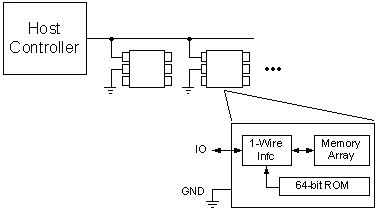





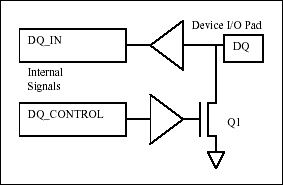






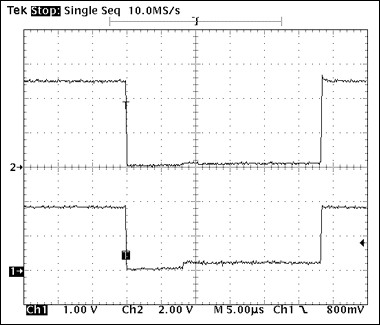
















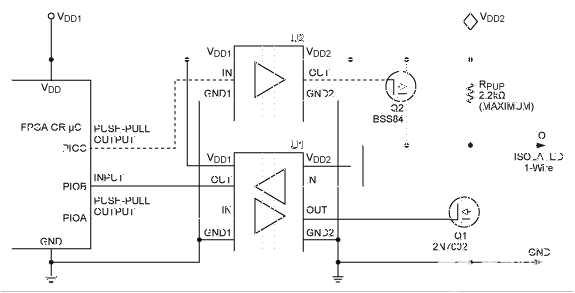






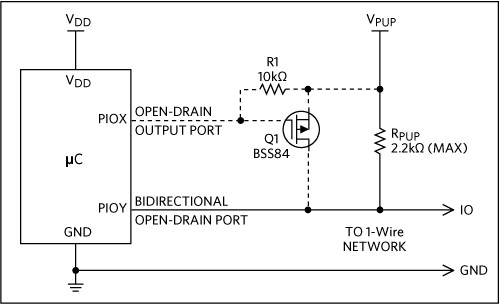













評論